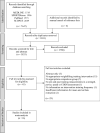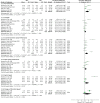Comparison of Weightlifting, Traditional Resistance Training and Plyometrics on Strength, Power and Speed: A Systematic Review with Meta-Analysis
- PMID: 35025093
- PMCID: PMC9213388
- DOI: 10.1007/s40279-021-01627-2
Comparison of Weightlifting, Traditional Resistance Training and Plyometrics on Strength, Power and Speed: A Systematic Review with Meta-Analysis
Abstract
Background: Weightlifting training (WLT) is commonly used to improve strength, power and speed in athletes. However, to date, WLT studies have either not compared training effects against those of other training methods, or been limited by small sample sizes, which are issues that can be resolved by pooling studies in a meta-analysis. Therefore, the objective of this systematic review with meta-analysis was to evaluate the effects of WLT compared with traditional resistance training (TRT), plyometric training (PLYO) and/or control (CON) on strength, power and speed.
Methods: The systematic review included peer-reviewed articles that employed a WLT intervention, a comparison group (i.e. TRT, PLYO, CON), and a measure of strength, power and/or speed. Means and standard deviations of outcomes were converted to Hedges' g effect sizes using an inverse variance random-effects model to generate a weighted mean effect size (ES).
Results: Sixteen studies were included in the analysis, comprising 427 participants. Data indicated that when compared with TRT, WLT resulted in greater improvements in weightlifting load lifted (4 studies, p = 0.02, g = 1.35; 95% CI 0.20-2.51) and countermovement jump (CMJ) height (9 studies, p = 0.00, g = 0.95; 95% CI 0.04-1.87). There was also a large effect in terms of linear sprint speed (4 studies, p = 0.13, g = 1.04; 95% CI - 0.03 to 2.39) and change of direction speed (CODS) (2 studies, p = 0.36, g = 1.21; 95% CI - 1.41 to 3.83); however, this was not significant. Interpretation of these findings should acknowledge the high heterogeneity across the included studies and potential risk of bias. WLT and PLYO resulted in similar improvements in speed, power and strength as demonstrated by negligible to moderate, non-significant effects in favour of WLT for improvements in linear sprint speed (4 studies, p = 0.35, g = 0.20; 95% CI - 0.23 to 0.63), CODS (3 studies, p = 0.52, g = 0.17; 95% CI - 0.35 to 0.68), CMJ (6 studies, p = 0.09, g = 0.31; 95% CI - 0.05 to 0.67), squat jump performance (5 studies, p = 0.08, g = 0.34; 95% CI - 0.04 to 0.73) and strength (4 studies, p = 0.20, g = 0.69; 95% CI - 0.37 to 1.75).
Conclusion: Overall, these findings support the notion that if the training goal is to improve strength, power and speed, supplementary weightlifting training may be advantageous for athletic development. Whilst WLT and PLYO may result in similar improvements, WLT can elicit additional benefits above that of TRT, resulting in greater improvements in weightlifting and jumping performance.
© 2022. The Author(s).
Conflict of interest statement
All authors (SJM, JLO, JSP, GGH and RSL) declare that they have no conflicts of interest relevant to the content of this review.
Figures




References
-
- Stone MH, Pierce KC, Sands WA, Stone MH. Weightlifting: a brief overview. Strength Cond J. 2006;28(1):50.
-
- Simenz CJ, Dugan CA, Ebben WP. Strength and conditioning practices of national basketball association strength and conditioning coaches. J Strength Cond Res. 2005;19(3):495–504. - PubMed
-
- Hori N, Newton RU, Nosaka K, Stone MH. Weightlifting exercises enhance athletic performance that requires high-load speed strength. Strength Cond J. 2005;24(4):50. doi: 10.1519/00126548-200508000-00008. - DOI
Publication types
MeSH terms
LinkOut - more resources
Full Text Sources
Medical

